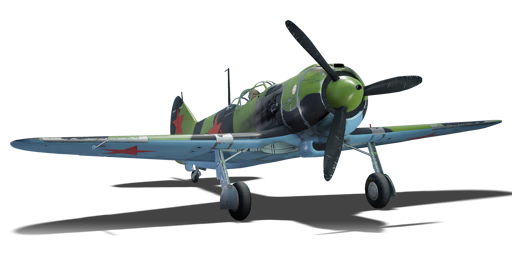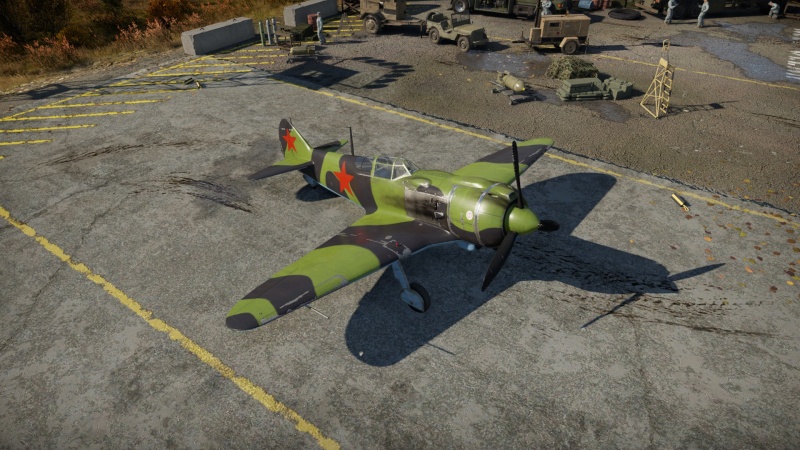La-5F
| This page is about the Soviet fighter La-5F. For other versions, see La-5 (Family). |
Contents
Description
The La-5F was a significant upgrade from its predecessor, the La-5. It was equipped with an improved M-82F engine that allowed for constant operation in overdrive mode, enhancing the aircraft's power output. The La-5F underwent various upgrades, including a reduced overall weight, new radio equipment, cockpit ventilation, lowered fuselage spine fairing, convex cockpit, and bullet-proof glass. The La-5F demonstrated superiority over the La-5, especially at low altitudes, with improved speed, climbing rate, and pilot operating conditions. Production of the La-5F continued until the end of 1943, with 4,150 units built.
It was introduced in Update 1.35. The aircraft behaves very similarly to the earlier La-5, but with an improved powerplant. The aircraft behaves good in boom and zoom tactics due to the reinforced wings, however the aircraft is not well suited for energy fighting. In terms of armament the La-5F still has two 20mm cannons, which is an excellent armament against other aircrafts, but may be lacking against enemy bombers and heavy twin engine fighters.
General info
Flight performance
The La-5F is a relatively heavy fighter which makes it a good candidate to perform Boom & Zoom tactics. Due to the reinforcements in its wings, it can execute rapid dives without the threat of breaking its wings. While limited turn engagements are possible under the right circumstances, excessive turning to include up to and past 180 degrees, will result in a significant amount of lost energy leaving the La-5F more times than nought, at the mercy of the enemy aircraft.
| Characteristics | Max Speed (km/h at 5,000 m) |
Max altitude (metres) |
Turn time (seconds) |
Rate of climb (metres/second) |
Take-off run (metres) | |||
|---|---|---|---|---|---|---|---|---|
| AB | RB | AB | RB | AB | RB | |||
| Stock | 569 | 548 | 9000 | 22.1 | 22.8 | 11.8 | 11.8 | 370 |
| Upgraded | 623 | 591 | 20.1 | 21.2 | 20.7 | 15.6 | ||
Details
| Features | ||||
|---|---|---|---|---|
| Combat flaps | Take-off flaps | Landing flaps | Air brakes | Arrestor gear |
| ✓ | ✓ | ✓ | X | X |
| Limits | ||||||
|---|---|---|---|---|---|---|
| Wings (km/h) | Gear (km/h) | Flaps (km/h) | Max Static G | |||
| Combat | Take-off | Landing | + | - | ||
| 0 | 310 | 447 | 418 | 270 | ~14 | ~14 |
| Optimal velocities (km/h) | |||
|---|---|---|---|
| Ailerons | Rudder | Elevators | Radiator |
| < 380 | < 380 | < 380 | > 341 |
| Compressor (RB/SB) | ||
|---|---|---|
| Setting 1 | ||
| Optimal altitude | 100% Engine power | WEP Engine power |
| 2,050 m | 1,540 hp | 1,870 hp |
| Setting 2 | ||
| Optimal altitude | 100% Engine power | WEP Engine power |
| 5,400 m | 1,330 hp | N/A |
Survivability and armour
- 55 mm Bulletproof glass - Windshield
- 66 mm Bulletproof glass (upgrades to 75 mm with "Armoured glass" modification) - Behind pilot
- 8.5 mm Steel (upgrades to 10 mm with "Rear armour plate" modification) - Behind pilot
- Self-sealing fuel tanks (1 in each wing, 1 below the cockpit)
Modifications and economy
Armaments
Offensive armament
The La-5F is armed with:
- 2 x 20 mm ShVAK cannons, nose-mounted (170 rpg = 340 total)
Suspended armament
The La-5F can be outfitted with the following ordnance:
- Without load
- 2 x 50 kg FAB-50 bombs (100 kg total)
Usage in battles
- Realistic Battles
Before engaging in aerial combat, it is essential to have a strategic plan to maximize your chances of success. One of the first steps in this process is to gain altitude and get an overview of the battlefield. Climbing to a height of 3,000-3,500 m provides a good vantage point to spot any potential threats and allows you to identify any enemy planes that might be flying at the same altitude or higher. These planes are potential hazards and must be dealt with immediately.
If you spot an enemy plane at the same altitude or higher, you have two options. You can either eliminate the threat by attacking the enemy plane or fly towards your allies if there are more than one fighter. It is essential to keep in mind that the presence of an enemy fighter at the same altitude or higher can significantly affect your chances of success in aerial combat. Thus, it is crucial to deal with them as quickly and efficiently as possible.
In the event that you are being tailed by enemy fighters, it is essential to use energy fight tactics to force them to overshoot you. By doing this, you can deplete their energy and end up on their tail, giving you the advantage in the fight. Your 20 mm ShVAKs can be highly effective in taking down enemy planes with short to mid bursts, and with 340 rounds, you can eliminate two or three enemies before having to return to the airfield.
Overall, having a strategic plan and being aware of your surroundings is crucial when engaging in aerial combat. By gaining altitude, identifying potential threats, and using energy fight tactics, you can maximize your chances of success and emerge victorious in aerial combat.
Manual Engine Control
| MEC elements | ||||||
|---|---|---|---|---|---|---|
| Mixer | Pitch | Radiator | Supercharger | Turbocharger | ||
| Oil | Water | Type | ||||
| Controllable | Controllable Not auto controlled |
Controllable Not auto controlled |
Controllable Not auto controlled |
Separate | Controllable 2 gears |
Not controllable |
Pros and cons
Pros:
- Good rate of climb without sacrificing speed (depending on the angle of climb)
- 20 mm cannons can chew up enemy aircraft especially when hitting in the right places
- Good at evading fire from gunners, rolling and turning can usually get you in close enough to engage an enemy aircraft
- Sturdy airframe that can take more damage than other fighters at the same BR
- The sturdy airframe and resistant engine will usually let you return to the airfield and repair after having been damaged
- The engine can perform in WEP for a long time until it reaches its cruising altitude
- ShVAKs cannons have little bullet drop and therefore a predictable trajectory, making eliminations up to one and a half kilometres possible with some practice
Cons:
- The 20 mm cannons only have 340 rounds of ammunition (170 rpg)
- Can be outmanoeuvred by more agile fighters, like Spitfires and Zeroes notorious for their exceptional turn rate
- Head-on fights will usually result poorly in the La-5F with many other enemy aircraft with superior weapon configurations for head-on attacks
History
| Archive of the in-game description | |
|---|---|
|
The M-82 initially had two operational modes: the so-called takeoff overdrive which allowed it to reach 1,700 hp, and its rated power mode which amounted to 1,330-1,350 hp. However, it could operate in overdrive mode for only 5-10 minutes. By the autumn of 1942, the A.D. Shvetsov design bureau had managed to upgrade the engine, giving it the ability to operate constantly in overdrive mode. In practice, this meant a significant addition to the aircraft's power output. From December 1942, the La-5 began to be equipped with the M-82F engine. At the same time, the aircraft's notation received the letter "F" (forsirovannyj, or supercharged). Apart from its powertrain, the La-5N received a number of other upgrades aimed at increasing its flight and combat characteristics. In particular, the aircraft's overall weight was reduced. The aircraft's armament remained the same as that of the La-5 Type 37. All the aircraft's radio equipment underwent changes; apart from the RSI-4 receiver, now every second airplane in the series had to be equipped with a transmitter, and every third with an RPK-10 fixed-loop radio compass. Air vents were installed in front of the cockpit windshield on both sides, to provide cockpit ventilation. From the spring of 1943, the La-5F began to be produced with a lowered fuselage spine fairing and a convex drop-shaped cockpit. The armoured headrest on the pilot's seat was swapped with bullet-proof glass. This and the improved quality of the plexiglas gave the pilot an excellent all-round view. An emergency release system was fitted to the cockpit canopy in order to ensure that if the plane was shot down, the stiff canopy would not prevent the pilot from jumping out of the plane and parachuting to safety. The La-5F was superior in all respects to its predecessor, the La-5, particularly at low altitudes, where it had a speed advantage of up to 40 km/h. Its climbing rate and operating conditions for the pilot had also been improved. Production of La-5F Type 39 continued until the end of 1943. The La-5F appeared in large quantities in the Kuban region, at Leningrad and at Velikiye Luki. In total, 4,150 were built, including the La-5F Type 37 with a fuselage fairing. | |
Media
- Skins
See also
Links to the articles on the War Thunder Wiki that you think will be useful for the reader, for example:
- reference to the series of the aircraft;
- links to approximate analogues of other nations and research trees.
External links
| Lavochkin Design Bureau (Лавочкинa Опытное конструкторское бюро) | |
|---|---|
| LaGG-3* | I-301 · LaGG-3-4 · LaGG-3-8 · LaGG-3-11 · LaGG-3-23 · LaGG-3-34 · LaGG-3-35 · LaGG-3-66 |
| La-5/7 | La-5 · La-5F · La-5FN · La-7 · Dolgushin's La-7 · La-7B-20 |
| La-9/11 | La-9 · La-11 |
| Jet Fighters | La-15 · La-174 · La-200 |
| Export | ␗La-9 · ␗La-11 |
| Captured | ▀La-5FN |
| *Lavochkin-Gorbunov-Gudkov (Лавочкин-Горбунов-Гудков), head designer V. P. Gorbunov | |
| USSR fighters | |
|---|---|
| I-15 | I-15 WR · I-15 M-22 · I-15 M-25 · I-15bis · Krasnolutsky's I-15bis |
| I-153 M-62 · Zhukovsky's I-153-M62 · I-153P | |
| I-16 | I-16 type 5 · I-16 type 10 · I-16 type 18 · I-16 type 24 · I-16 type 27 · I-16 type 28 · I-180S |
| I-29 | I-29 |
| I-185 | I-185 (M-71) · I-185 (M-82) |
| I-225 | I-225 |
| ITP | ITP (M-1) |
| MiG-3 | MiG-3-15 · MiG-3-15 (BK) · MiG-3-34 |
| LaGG | I-301 · LaGG-3-4 · LaGG-3-8 · LaGG-3-11 · LaGG-3-23 · LaGG-3-34 · LaGG-3-35 · LaGG-3-66 |
| La | La-5 · La-5F · La-5FN · La-7 · Dolgushin's La-7 · La-7B-20 · La-9 · La-11 |
| Yak-1/7 | Yak-1 · Yak-1B · Yak-7B |
| Yak-3 | Yak-3 · Eremin's Yak-3(e) · Yak-3P · Yak-3T · Yak-3U · Yak-3 (VK-107) |
| Yak-9 | Yak-9 · Yak-9B · Golovachev's Yak-9M · Yak-9T · Yak-9K · Yak-9U · Yak-9UT · Yak-9P |
| Other countries | ▂P-40E-1 · ▂P-47D-27 · ▂Hurricane Mk IIB · ▂Fw 190 D-9 · ▂Spitfire Mk IXc |
| P-39 | ▂P-39K-1 · ▂Pokryshkin's P-39N-0 · ▂P-39Q-15 |
| P-63 | ▂P-63A-5 · ▂P-63A-10 · ▂P-63C-5 |





